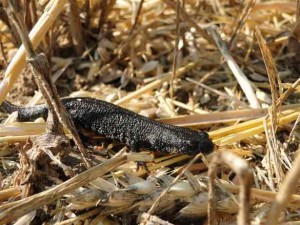In this post, Carsten Brühl informs about their recently published paper “Temporal coincidence of amphibian migration and pesticide applications on arable fields in spring”.
Agricultural intensification is discussed as a significant factor for the decline in amphibian populations. With 40% global land coverage, the agricultural landscape is regarded as one of the largest terrestrial biomes on Earth, and therefore represents an essential habitat for amphibians. For example, in 2009, about 52% of German land area was used for agriculture, 70% of which (about 130,000 km2) was cropped area with related pesticide applications.
Although the public generally associates amphibians with an aquatic environment, most temperate amphibians live outside the breeding season in terrestrial habitats. In agricultural landscapes, breeding habitats (ponds and temporary wetlands) are often completely surrounded by arable land. Therefore for reproduction, amphibians regularly have to cross agricultural land during migration from terrestrial to aquatic habitats. During the terrestrial phase the uptake of pesticides through the skin can cause lethal or sub-lethal effects and recent laboratory studies showed high toxicity of commonly used pesticides to amphibians at field application rates. To date real terrestrial exposure data of amphibians based on crop and pesticide application data are lacking and therefore it is difficult to assess the realism of previously acquired laboratory data.
First analysis of coincidence of amphibian breeding migration and pesticide application
Pesticide management differs between crops and farms, particularly with regard to type, number, amount and date of pesticide applications. Such variations in pesticide application strategies result in different temporal coincidence with amphibian species. For the first time, the presence of four amphibian species in agricultural fields was monitored. Together with Gert Berger from the Leibniz Centre for Agricultural Landscape Research (ZALF) in Müncheberg, we analysed the temporal coincidence of more than 330 pesticide applications with the breeding migrations of adult amphibians in two years on 100 fields. The data was collected in a large field monitoring study in an intensively used agricultural landscape in the North-Eastern Plain of Germany. The researchers evaluated a realistic exposure to pesticides, including the potential interception by various crops at different growth stages.
Late migration species more affected
The study found that the level of species-specific coincidence depended on the performed pesticide management, determined by the timing, crop, number and type of pesticide applications. Late migrating species, such as European fire-bellied toad and common spadefoot toad, overlapped more with pesticide applications than early migrating species, such as moor frog. Up to 86% of the population of common spadefoot toad experienced a temporal coincidence with a single fungicide application in winter rape fields when the plants were comparatively high and 80% of the pesticide amount was expected to be intercepted by the plant material. In maize, 17% of the population of fire-bellied toad encountered a single herbicide application when the field was bare soil, therefore receiving the full field application rate. The data show that many amphibians can be present in fields when plants are high and therefore interception reduces the risk of direct overspray. Or a comparatively lower proportion of the population might receive a full field rate exposure of a pesticide. However the resulting effects of the detected coincidences are not clear since the toxicity of only few pesticides has been evaluated in laboratory studies. In the laboratory some pesticides resulted in 100% mortality at field rates and others reached 40% mortality at 10% of the field application rate. Additionally field data is only available for two years and pesticide effects are expected to take more time to show effects on the population size of amphibians.
Adjustment of pesticide management is necessary
To reduce temporal coincidence and thus potential risk of pesticide exposure of amphibians, local monitoring of amphibian migration should be combined with adjusted pesticide management. There is also a need for a solid knowledge of the effects of pesticides and to introduce the issue in the regulatory registration procedures.
The article was authored by Patrick P. Lenhardt, Carsten A. Brühl, Gert Berger and was published in Basic and Applied Ecology.

